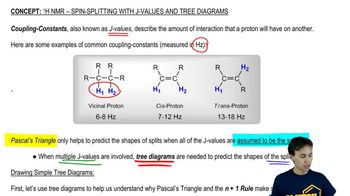Here are the essential concepts you must grasp in order to answer the question correctly.
NMR Multiplicity
NMR multiplicity refers to the splitting of NMR signals into multiple peaks due to spin-spin coupling with neighboring non-equivalent protons. The number of peaks in a signal is determined by the n+1 rule, where n is the number of neighboring protons. Understanding multiplicity is crucial for interpreting NMR spectra and identifying molecular structures.
Recommended video:
Triplet Signal
A triplet in NMR spectroscopy is a signal that splits into three peaks. This occurs when a proton is coupled with two equivalent neighboring protons. The intensity ratio of the peaks in a triplet is typically 1:2:1, reflecting the statistical likelihood of different spin states of the neighboring protons.
Recommended video:
Identifying Proton Signals
Pascal's Triangle
Pascal's Triangle is a mathematical tool used to determine the intensity ratios of peaks in NMR multiplets. Each row of the triangle corresponds to the coefficients of the binomial expansion, which represent the relative intensities of the peaks in a multiplet. For a triplet, the relevant row is 1:2:1, indicating the peak intensity distribution.
Recommended video:
Splitting with J-Values:Simple Tree Diagram
 Verified step by step guidance
Verified step by step guidance Verified video answer for a similar problem:
Verified video answer for a similar problem:



 8:06m
8:06m